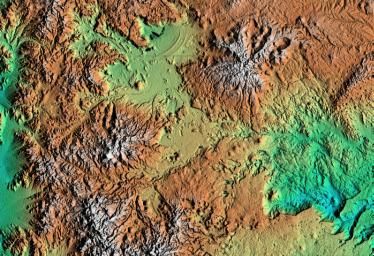This topographic image of Patagonia, Argentina shows a spectacular landscape formed by volcanoes, rivers, and wind. The area is located just east of the narrow range of the Andes Mountains, about 100 kilometers (62 miles) east of the border with Chile. Interesting features include basalt-capped mesas with sinkholes (lower center), arcuate ridges of windblown beach sands downwind from a salty desert lake (upper center), young volcanic cones(right), and at least one case of what geologists call "inverted relief." This happens when lava flows down a valley in soft material and then the soft material is eroded away leaving the former valley as a ridge of lava. These ridges can be seen on the slopes of the volcano in the upper right. Geologists will use SRTM topographic data to study the interaction of volcanic, climatic and erosional processes.
This shaded relief image was generated using topographic data from the Shuttle Radar Topography Mission. A computer-generated artificial light source illuminates the elevation data to produce a pattern of light and shadows. Slopes facing the light appear bright, while those facing away are shaded. On flatter surfaces, the pattern of light and shadows can reveal subtle features in the terrain. Colors show the elevation as measured by SRTM. Colors range from blue at the lowest elevations to white at the highest elevations. This image contains about 1100 meters (3600 feet) of total relief. White speckles on the face of some of the mountains are holes in the data caused by steep terrain. These will be filled using coverage from an intersecting pass.
The Shuttle Radar Topography Mission (SRTM), launched on February 11, 2000, uses the same radar instrument that comprised the Spaceborne Imaging Radar-C/X-Band Synthetic Aperture Radar (SIR-C/X-SAR) that flew twice on the Space Shuttle Endeavour in 1994. The mission is designed to collect three-dimensional measurements of the Earth's surface. To collect the 3-D data, engineers added a 60-meter-long (200-foot) mast, an additional C-band imaging antenna and improved tracking and navigation devices. The mission is a cooperative project between the National Aeronautics and Space Administration (NASA), the National Imagery and Mapping Agency (NIMA) and the German (DLR) and Italian (ASI) space agencies. It is managed by NASA's Jet Propulsion Laboratory, Pasadena, CA, for NASA's Earth Science Enterprise, Washington, DC.
Size: 225 km (140 miles) x 170 km (105 miles)
Location: 41 deg. South lat., 69 deg. West lon.
Orientation: North toward upper right
Original Data Resolution: 30 meters (99 feet)
Date Acquired: February 19, 2000

 Planetary Data System
Planetary Data System












